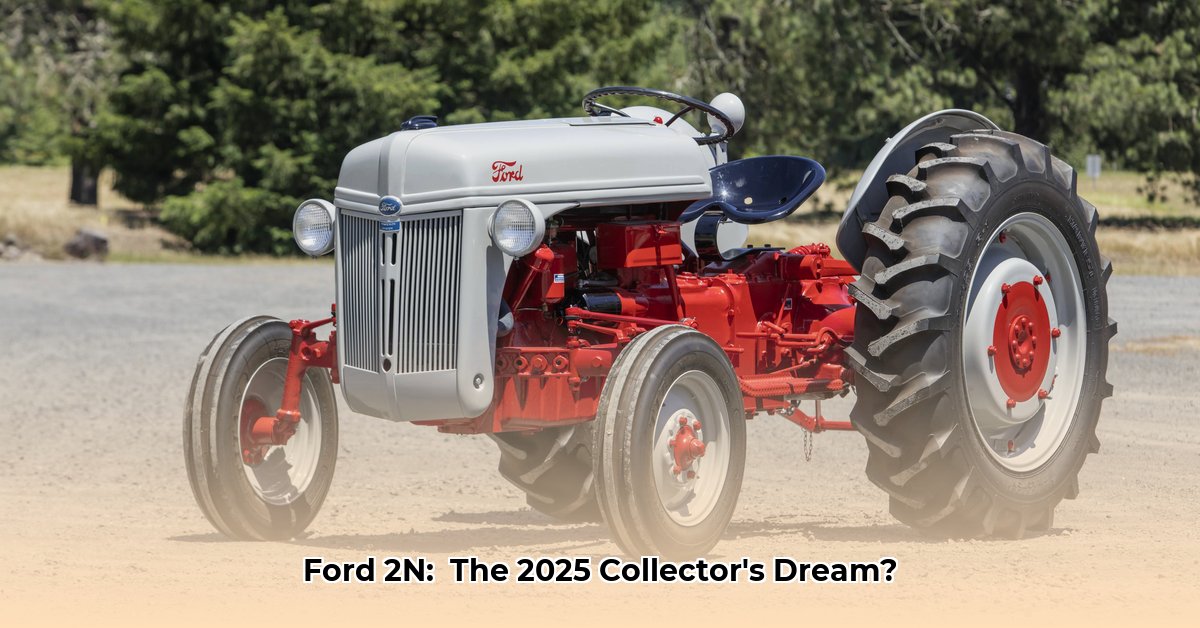
The Ford 2N tractor: a timeless icon, a symbol of agricultural heritage, and a surprisingly resilient machine still sought after today. But navigating the world of buying, selling, or restoring a 2N requires knowledge and strategy. This guide provides a comprehensive overview of the Ford 2N market, offering practical advice for both seasoned enthusiasts and newcomers. Whether you're a collector, farmer, or hobbyist, we'll equip you with the insights to make informed decisions. For sourcing hard-to-find parts, check out this helpful resource: Ford 8N parts.
Understanding the Ford 2N Tractor Market
The Ford 2N market is a vibrant ecosystem with fluctuating prices influenced by several key factors. Condition plays a crucial role; a meticulously restored 2N will demand a significantly higher price than one requiring extensive repairs. Location impacts value, reflecting regional demand and collector density. Finally, the buyer's profile—collector, farmer, or hobbyist—will influence pricing and desired features.
Visualizing Value: (Insert chart/graph visualizing price trends based on condition, location, and restoration status).
Horsepower Inconsistencies: Be aware that horsepower figures may vary across sources due to inconsistent reporting methods throughout the 2N's production run. Focus on the overall mechanical condition rather than solely on horsepower claims. A well-maintained tractor, regardless of slight variations in reported horsepower, will always hold more value.
Who's Buying? The Ford 2N market attracts a diverse range of buyers:
- Collectors: Prioritize originality and pristine condition.
- Farmers: Seek reliable, functional machines for practical use.
- Hobbyists: Enjoy the challenge of restoration and often customize their tractors.
Isn't it fascinating how such a seemingly simple machine can appeal to such a diverse group?
Buying a Ford 2N Tractor: A Step-by-Step Guide
Finding the right Ford 2N requires diligence and a methodical approach. This step-by-step guide will increase your chances of securing a great tractor at a fair price.
Step 1: The Search Begins
Begin your search online: explore marketplaces like eBay and specialized forums dedicated to vintage tractors. Local farm auctions and classifieds frequently feature excellent finds. Don't underestimate the power of word-of-mouth; networking within farming communities or vintage tractor clubs can uncover hidden gems.
Step 2: The Pre-Purchase Inspection (Essential!)
A thorough pre-purchase inspection is absolutely crucial. Before you commit to a purchase, conduct a detailed hands-on review. Here's a checklist:
- Engine: Check compression, look for leaks, verify fluid levels (oil, coolant).
- Transmission: Test shifting smoothness, listen for unusual noises.
- Hydraulics: Ensure all systems function correctly.
- Tires: Assess condition, tread depth, and wear.
- Frame and Body: Inspect for rust, damage, or poorly executed repairs.
- Documentation: Verify ownership history, check for original manuals or registration paperwork.
If you lack mechanical expertise, consult a qualified vintage tractor mechanic. This pre-emptive step significantly reduces the risk of expensive post-purchase surprises.
Step 3: Price Negotiation
Research comparable sales to establish a fair market value before making an offer. Websites and forums dedicated to vintage tractors provide valuable data for comparison. Remember, negotiation is part of the process. Be assertive, but fair. Walking away from an overpriced tractor is a sign of a shrewd buyer.
Step 4: Financing
Explore various financing options, such as farm equipment loans or private financing, before finalizing your purchase.
Owning and Maintaining Your Ford 2N Tractor
Owning a Ford 2N is a rewarding experience, but it requires ongoing care and attention.
Parts Sourcing: Acquiring parts for a vintage tractor can sometimes be challenging. Build relationships with specialized parts suppliers, explore online forums, and check local salvage yards.
Routine Maintenance: Consistent maintenance is essential. Establish a routine maintenance schedule including regular oil changes, filter replacements, and lubrication. This prevents costly repairs and prolongs the life of your tractor. (Insert sample maintenance schedule).
Repair and Restoration: Minor repairs are often manageable, but major restorations are best entrusted to experienced mechanics. Online forums and local tractor enthusiast groups are invaluable sources for advice and support.
Selling Your Ford 2N Tractor
When the time comes to sell your 2N, follow these steps for a successful transaction.
Pricing: Research recent sales of comparable tractors to set a fair asking price, accounting for condition, restoration, and market trends.
Marketing: Utilize online marketplaces, specialized forums, and local classifieds for optimal reach. High-quality photos are essential.
Negotiation: Remain professional and transparent throughout negotiations. Fairness is key to a smooth transaction.
Key Takeaways
- Condition is paramount: The condition of the tractor significantly impacts its value.
- Research is vital: Thorough market research is key to fair pricing in both buying and selling.
- Pre-purchase inspection is non-negotiable: Don't skip this crucial step!
- Community is key: Join online forums and local clubs for expert advice and support.
This guide provides a solid foundation for exploring the rewarding world of Ford 2N tractors. Remember, patience, research, and a careful approach are your best allies in this journey. Happy tractoring!